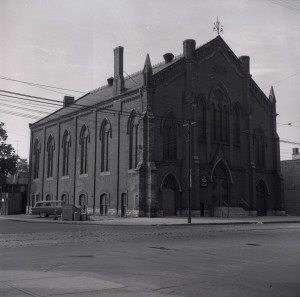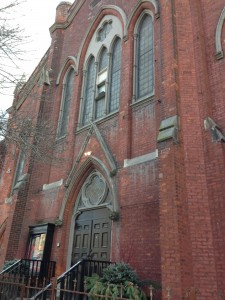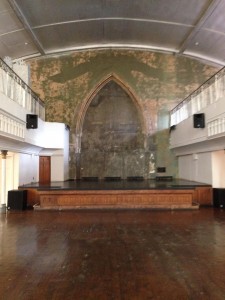Berkeley Church Site Analysis
Site: Berkeley Church
Location: 315 Queen St E, Toronto, ON M5A 1S7
The diversity of venues in the Toronto area that contribute to the dissemination of popular music on a daily basis is abundant. Whether it be large venues like the Air Canada Centre or smaller venues such as the Opera House the performing of popular music is entrenched in these venues. Music has always played an important role in the culture of this city and the numerous venues, both old and new, display this. For this site analysis I will be looking at Berkeley Church which is located in the heart of downtown Toronto. Berkeley Church is located at 315 Queen St E just east of Eaton Centre Mall in one of the oldest parts of Toronto. It was a church that was converted into a venue that is known for hosting weddings, corporate events, parties, conferences, and even some concerts. The venue suits these types of events as it is an open space with multiple floors making it spacious for those attending. Being in the heart of downtown Toronto makes this venue an attractive spot for those looking to host an event.
Berkeley Church in 1956
Historical Overview
Berkeley Church was built in 1871 as a Wesleyan Methodist church, a branch of Protestantism, which emerged from Britain in the early 1800’s. Methodism eventually made its way to Canada and Berkeley Church was one of the first churches to be built in Toronto for this religion. Being such a significant structure of the history of Toronto it has been protected by the Ontario Heritage Act of 1997. This keeps it safe from redevelopment or demolition as it is seen as a structure that is a part of the history and fabric of not only Toronto but the province of Ontario. Methodism played an important role not only in the history of Canada but North America as a whole being one of the most practiced religions from the mid 1700’s to the end of the 1800’s. (Playter, 1862, 3). It first gained popularity in the United States then due to proximity made its way to Canada where preachers began to spread the word. John Wesley was one of the main founders of this religion and after his death in 1791 is when the religion began to grow in popularity. The main goal of this religion was to help the poor and spread the missionary spirit by building churches, universities, orphanages and hospitals. Therefore the main goal of this religion is performing social services for others which in turn will put you in God’s good graces. The growth of this religion eventually spread to Toronto which led to the creation of Berkeley Church in 1871. It was used as a church for over a hundred years until it went through some transitions into what it is today, an event venue.
Designated Heritage Site
The neighbourhood it is a part of is known as the King and Parliament area and as stated in a Toronto Urban Design Guidelines it is a part of the original ten blocks of “The Old Town of York.’ More specifically Berkeley Church is located in the section of Toronto known as The Corktown Mixed Use Area which starts south-east of Queen St. And Parliament and extends to the Don River. According to the city’s plan to redevelop this area stated in the Toronto Urban Design Guidelines that was created in 2004, the main goal is to incorporate new development within this area while at the same time respecting the numerous historical sites. Therefore although Berkeley Church has been transformed from its original use the actual structure still stands the same. This redevelopment in essence is trying to pay respect to the past while developing the old area to bring new life to it. With this in mind the revitalization of this area will only benefit places like Berkeley Church as it will only attract more business once the redevelopment is complete. The Berkeley Church tends to appeal to the downtown, urban type who appreciate the building’s architecture and quirkiness also it appeals to those of a creative nature (artists, musicians, designers, etc,).
Going back to the history of Berkeley Church it eventually operated as the film studio for the United Church. Although in 1992 the United Church moved their studio to Mississauga and the building was unused for four years. In 1999 the current owners purchased the heritage building and converted it into an event venue; in 2007 the owners expended the operation purchasing the Lumber Yard property next door, calling it the Field House which is now another event space. The current owner of this venue is seventy-five year old Doug Wheler and his company which is Plumtree Group Projects. Some of his other projects stated in the Globe and Mail article include, “expanding his five distinct party locations to seven, including two whimsical venues mostly completed, as well as developing an ambitious green condominium project that could be groundbreaking in this city.” (Globe and Mail, 2007) Keeping with his green initiatives Mr. Wheler looks to make Berkeley Church the first all green music venue in Canada. There are certain requirements to obtain a Leadership in Energy and Environmental Design (LEED) certification which he looks to get for Berkeley Church. This can be linked to the redevelopment of the area as Mr. Wheler looks to give his venue the uplift it needs while at the same time respecting the heritage site. In order to become certified for LEED the renovations that need to be completed such as replacing doors and windows is being done by reusing materials from demolition sites. With these initiatives being taken Berkeley Church looks to be a prime small scale event spot for the time being and the foreseeable future.
Site Analysis
Present Day Berkeley Church
Berkeley Church is a unique event venue in the downtown core that attracts many who enjoy its historical significance and architecture. It is a smaller venue which can hold up to several hundred patrons depending on the event. The most common events held here when I asked interviewee number responded as such, “Hosting approximately hundred and fifty events per year, the most common would be weddings, followed by fundraisers and corporate events. The space is also used for photography and film shoots although not as common.” With weddings being the most common I will examine how music is experienced at this venue during these events. Interviewee number two is someone who had attended a wedding at Berkeley Church this past summer. The first question I asked her was, “What type of music was played and how did the acoustics sound in this venue?” She responded by saying, “I always look forward to the music at weddings and at this particular wedding it was a live band. The sound they produced was good in the environment, limited feedback and no echoing.” This comment shows how music plays a significant role in how a space is produced. As Cohen states, “The consumption and production of music draws people together and symbolizes their sense of collectively and place” (Cohen, 1998, 3) Weddings are a perfect example of this last statement as music and dance are two of the most important factors in any wedding. When I went to observe this space on my own time it seemed to be a good place for musical performances as the stage is the central focus point with a two level area for the crowd to observe. At the time I went there were only four speakers but I was told by interviewee number one that for the most part it is more than enough.
They fact that this venue has two floors can be beneficial as it allows larger numbers to attend the venue. It also allows movement in the space and different views to be accessed throughout an event. This is why corporate events are popular at this location not only because of the intimate yet good flow of the space but the location of the space itself. When talking to interviewee number one he told me that the fact that Berkeley Church is located in the heart of Toronto it attracts many businesses for corporate functions.
Stage at Berkeley
Although the musical experience was a positive one how the physical architecture on the site was experience was a negative one. I asked interviewee number three who attended the same wedding as interviewee number two, “What is your overall experience of Berkeley Church? Positive or Negative? Reasons?”. He responded by saying, ‘The space as a whole felt a little cramped at times and the venue was very warm making it uncomfortable for the most part. Also the two level division for seating the guests made it a bit awkward as those on the mezzanine had to stand around the balcony and look down to see what was going on. Therefore I would have to lean more to the negative side.” Interviewee number two also leaned toward the negative side. This shows how important space is to the overall experience of an event even if the musical aspect is a positive one.
One of the more interesting things about this venue is the versatility it provides for events meaning that it can be a place of music just as quick as it can be a place for presentation. Berkeley Church is what Schaffer calls a soundscape which he states is a landscape of sound. (Schaffer, 1994, 3). It is a unique space as it allows a more intimate gathering where the musical aspect of an event can easily be the focal point just as quick as it can be background noise. Talking to interviewee number one allowed for me to get a better understanding of what special types of events had been held at Berkeley Church. He told me that The Night Out with Bill Clinton for the Clinton Foundation Millennium Network that was held on June 4th 2013 was one of the biggest and most memorable events held at Berkeley Church. The event was for Bill Clinton to discuss some of the social and environmental issues that we need to conquer in order to have a better future. This was the main purpose of the event but there were also musical aspects involved in the night with Tegan and Sara, a popular alternative group, performing with Rachel McAdams hosting the evening. Therefore even though people were attending a function such as Bill Clinton’s event music still played an important role in the gathering of these people to the space. Not only did Tegan and Sara perform but Bill Clinton showed off his well known saxophone skills with some motivation from Rachel McAdams. This was one of the more special events held at Berkeley Church and it took place not long ago. This shows how the venue is coming to be one of the popular venues to host events at here in Toronto. What can be learned from this event is the versatility that this venue holds as one can make the quick switch from talking to performing. It is an intimate venue where the crowd can get up close and personal with the performance.
Conclusions
Berkeley Church is a unique venue to hold a variety of events including weddings, corporate functions, concerts and fundraisers. All these events usually involve some type of music being played and from my observations and findings the way music is experienced in this venue is a relatively positive one. The one problem that I found was that this venue was not the most physically comfortable venue to be in especially during weddings. This affects the overall experience because although the music may sound good in the venue the space is uncomfortable. In order for a venue to have an overall positive experience both the music and space must blend together well. That being said Berkeley Church will continue to be one of the more popular venues for downtown crowds to host and attend events. The recent Bill Clinton event is one example of the growing reputation that this venue has obtained and will continue to do so in the future.
References
Berkeley Church Events website:
http://1871berkeleychurch.com/our-space/
Berkeley Church 1956 Photograph. (1956) Retrieved November 27, 2013 from http://static.torontopubliclibrary.ca/da/images/LC/pictures-r-5772.jpg
Bill Clinton Banner Photo. (2013) Retrieved November 28, 2013 from http://www.bestoftoronto.net/2013/06/the-night-out-with-bill-clinton-for-the-clinton-foundation-millennium-network/
Cohen, S. (1998). Sounding Out the City: Music and the Sensuous Production of Place. In A. Leyshon, D. Matless, and G. Revill (Eds.), The Place of Music (pp. 434-446). New York: The Guilford Press.
Playter, George F. (George Frederick). The history of Methodism in Canada : with an account of the rise and progress of the work of God among the Canadian Indian tribes, and occasional … Toronto, 1862. 422pp.
Rodriguez, R. The Night out with Bill Clinton for the Clinton Foundation Millennium Network (2013, June 10). Best of Toronto. Retrieved from
Sayej, N. The Berkeley Church gets the green light (2007, December 22). Globe and Mail. Retrieved from
http://www.theglobeandmail.com/news/national/the-berkeley-church-gets-the-green-light/article700300/
Schafer, R. M. (1994). The Soundscape. Rochester: Alfred Knopf, Inc.
Sterne, J. (1997). Sounds like the Mall of America: Programmed Music and the Architectonics of Commercial Space. Ethnomusicology, 41(1), 22-50.
Toronto Urban Design Guidelines. King and Parliament (June 2004) http://www1.toronto.ca/staticfiles/city_of_toronto/city_planning/community_planning/files/pdf/14kingparliament.pdf



